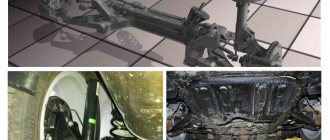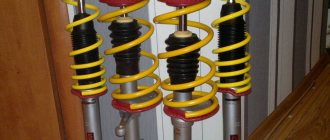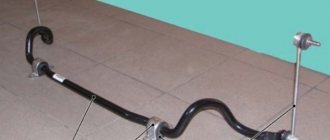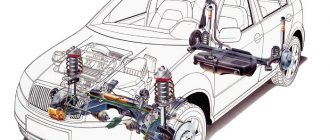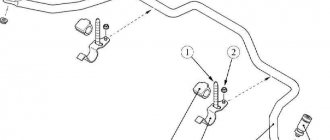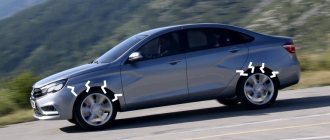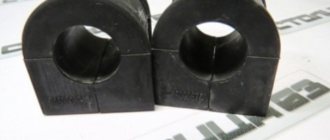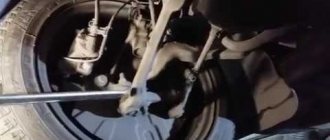Good evening to all readers!
As soon as I bought the car, a few days later I immediately heard an unpleasant knocking sound when speed bumps passed, and the knocking sound was like “knock-knock” or “knock-knock”, very unpleasant... I immediately went to the dealer a few days later. I arrived in Major, their specialist sat down with me and we started driving around the territory, as luck would have it, the car never creaked, it looks like the cops were too old, because... This jamb is heard only with strong suspension travel.
I arrived home and started digging on the Internet. As it turns out, I'm not alone in this issue. Many people have this problem. So one person wrote that the problem was in the stabilizer bushings and struts. I advised you to buy Chevrolet Niva polyurethane bushings.
At first I didn’t buy the bushings, I went to a different dealer, I didn’t like the service at Major, they only wanted to rip it off and not solve the problem. In general, I came, they replaced my stabilizer bars under warranty and tightened the subframe, the knocking became less... So I drove for some more time...
Then I found stabilizer bushings from a Chevrolet Niva, VIN number 17012680, ordered them on autodoc.ru. I came to the dealer, they changed them for me, and VOILA! It's all gone! No more squeaks, knocks and other crap, the shock absorbers work smoothly, nothing hits anywhere.
Do you have a Vesta, does the front suspension squeak or knock? Then the Chevrolet Niva bushings are already coming to you!))) Definitely a MUST HAVE!
The rear and front suspension are components that cannot be repaired, they need to be monitored. The suspension of a Lada Vesta car is almost the first parameter after the engine by which a car is selected. Its design is simple, maximally adjusted for broken roads. But it also happens that the front suspension of the car rattles, creaks and knocks - the reason for this is either wear of parts or defective parts. Read the article below on how to diagnose and solve suspension problems. With careful driving, the Lada Vesta car has a service life of 90,000 km. For daily trips, it is not permissible to take a low car, because its advantages will be destroyed by snow-covered courtyards and potholes on the roads. These units must be strong to withstand long-term use.
The design of the new suspension, which is included in the design of the Lada Vesta, is strikingly different from previous generations. The front chassis has become more complex and soft. This does not mean that a speed bump can be passed at high speed - driving at normal speed will be smoother, because the mechanism “absorbs” some of the vibrations. Read the article to the end and find out why knocking occurs in the front suspension
The chassis is the link between the wheels and the body. The wheels take all the impacts - from speed bumps, holes, potholes, curbs, and other irregularities that are on the way. The task of the mechanism is to soften the blow, reduce the rolling amplitude, while maintaining the integrity and functionality of the internal traces and assemblies - if they hit each other, this will lead to their unsuitability.
The more advanced representatives of the family's model range also distinguished themselves - the rear suspension of the Lada Vesta SV Cross is stronger than that of the standard version, it can withstand heavier loads, which allows it to carry more luggage.
Front suspension device
The design of the unit has changed noticeably. Even before repairing new Vests, technical centers had to be trained on the new model. The front suspension sits on a subframe, which was not seen on earlier VAZ models. As a result, the upper part above it (engine compartment, steering rack, etc.) received protection, and the lower part of the suspension received static fasteners. The steering rack, which is located above the subframe, is still located slightly lower than it was on previous models. This means that the steering linkage now works directly with the steering knuckle.
The steering shaft is supplemented with an electric power steering, which transmits the turning forces of the steering wheel to the wheels. The rack transmits force to the rods, and they work with the hubs - they allow you to control the movement of the wheels under control. The hub is also pressed against the disc brake, controlling the uniformity of its contact with the wheel.
Defects of Lada
Lada Vesta has recently rolled off the assembly line and not all warranty workshops have experience in solving problems on how to eliminate knocking noises that occur in the suspension. The manufacturer constantly maintains contact with the service station and makes changes to the design. Let's consider possible malfunctions and methods for eliminating them in the front suspension of the Lada.
Car enthusiasts may be disappointed by a new car almost immediately. An unpleasant creaking and knocking sound appears when passing speed bumps. Upon analysis, it turned out that the problem was in the stabilizer bar bushings.
It is not recommended to lubricate them with grease; they will stop squeaking, but for a very short period of time, so they only need to be changed. They can be replaced with polyurethane ones from Niva Chevrolet. The bushing has catalog number 17012680. After replacement, the squeaking sound disappears.
You should know that these are not all problems; a characteristic knocking sound may occur from the front right.
This is typical when there is increased play in the right ball joint. Replacement is carried out together with the suspension arms assemblies. AvtoVAZ supplies them complete with a ball joint. Front suspension of the Lada Vesta The main defects that occur in the front part of the Vesta car, which may cause the car to creak or rattle:
- Grinding noise in the anti-roll bar;
- The right ball joint is faulty, it starts knocking;
- The stabilizer links begin to rattle.
It is recommended that all these defects be repaired at AvtoVAZ dealerships.
When driving on an uneven road, you hear a dull knock on small bumps or a sound reminiscent of rubber friction. This problem can be eliminated by lubricating the Vesta muffler mounting with grease. Vesta's front suspension creaking may be due to worn struts.
Self-diagnosis of problems
If you don't like the way your vehicle drives over obstacles after a while, or turns into turns less smoothly. First, carry out diagnostics to eliminate other “suspects” and come to the technical center with a clear task for specialists:
- Release the brake pedal. Take the wheel with both hands by the opposite parts and rock it. If a pronounced play is noticeable, this may mean that the problem is in the hub bearing - it must guide the wheel correctly, strictly in one plane; if it is neglected, it can “go figure eight”.
- If the wheel play does not occur due to the hub, then the fault is in the chassis. In this case, play appears even when the brake pedal is pressed.
- If the car “wobbles” in a vertical plane, the stabilizer link is poorly secured or the ball joint is worn out.
- If the car wobbles “horizontally” (push it into the front fender, after tightening the handbrake), it may be that the rod ends have worn out and become unusable.
The design of the front suspension of a front-wheel drive vehicle assumes that all its parts should “age” evenly, almost equally, that is, even if they have different wear patterns, they need to be replaced with new ones in pairs. New components will work evenly, “erasing” from scratch.
Wear of stabilizer link joints
When diagnosing stabilizer bushings, as a rule, all elements of the front suspension are inspected and, first of all, the vertical struts of the anti-roll bar (article no. 8450006750), which also often fail in Lada Vesta.
Lada Vesta produces standard stabilizer bars. These parts are of fairly high quality, but they also have their own resource, which depends on many factors. The degree of wear of the vertical struts is determined by the presence of play in their hinges - if the struts knock when the stabilizer is suddenly manually moved, they need to be replaced. Knowing the length of the struts (283 mm), you can select even better parts for replacement, for example, from Toyota or Hyundai.
- socket wrench “16” - unscrewing the nut;
- Torx key 30 – pin locking.
Production of replacement racks
The work is carried out on a car lift. Replacing parts with new ones is not difficult: fix the finger with one key, and unscrew the nut with the second.
Detected malfunctions in the suspension
Even during the release of the first batches of Vesta from the assembly line, buyers rightly noticed shortcomings in its work, which were corrected in subsequent batches. The sounds that the rear or front suspension can make are very varied - the design is very complex, consisting of many parts that can fail. However, the most common breakdowns among Lada Vesta owners stand out and are worth disassembling.
Creaking, crunching, knocking from the rear suspension of the Lada Vesta
Rear crunching is a fairly old problem for West. The knock of the rear chassis is corrected according to a special instruction from AvtoVAZ, according to which the design will have to be slightly supplemented. Between the upper support and the rear shock absorber strut you need to place a washer with a length of 130 mm, a distance between the holes of 100 mm (hole radii - 5 mm), a base radius of 34 mm, and finally a radius of the main hole of 25 mm.
The crunch will disappear, but only if the washer matches the dimensions, otherwise a gap will appear between the body and the support, into which dirt gets trapped. The cause of concern due to crunching or knocking may also be:
- worn trunk lid damper;
- stretched handbrake cable (it can be pulled from the passenger compartment);
- trunk lock;
- rear sofa backrest fasteners.
And just in case, check the contents of the trunk itself - there may just be tools rattling around there.
Bumping knocks and noises in the front suspension of Lada Vesta
- The first, most popular reason for calling for service is the thumping (knocking) sound of the front suspension of the Lada Vesta, which comes from the stabilizer. Typically occurs when driving over artificial bumps. Stabilizer bushings, unfortunately, are not suitable for long-term use; even lubricant will not help - the only way to treat them is by replacing them. To solve the problem, you can install polyurethane bushings from Niva Chevrolet, its number is 17-012-680.
- The second reason for knocking can be called play of the ball joint, when a large gap is created between the parts. Problems can be solved by changing the design with levers. A grinding noise can be heard due to wear on the stabilizer struts and can mean that the car is gradually “losing” confidence when cornering.
- The creaking of the front suspension is caused by the hinges of the stabilizer struts. While driving, a knocking noise may occur due to insufficient tightening of the wheel bolts. When such a sound is heard, it is better to contact a service station as quickly as possible to prevent parts from breaking.
- The reason why the suspension on the Lada Vesta rattles and creaks can be heard may be that one of the parts has worn down to a sufficient level and is now knocking against another. To notice damage in time, it is enough to periodically inspect your car. If something is rattling, the part can be identified by shaking the car.
- If crunching or knocking noises in the front suspension are heard infrequently, the cause most likely may be a torn steering rod oil seal. This oil seal is in very close contact with the subframe of the vehicle (the distance between them at rest is 1 cm), and they collide at every bump. The oil seal breaks, and the connection of the rod to the rack hits the subframe.
Loose wheel bolts
The situation when the fastening bolts of one or several wheels have become loose is typical not only for Lada Vesta, but occurs frequently. There can be many reasons - from inattention during tire fitting to an unsuccessful attempt to steal a wheel.
If a knocking sound occurs while driving, the first step is to perform the most accessible action - stop the car and check the tightness of the wheel bolts, since a tire that falls off while turning can cause the car to roll over with unpredictable consequences. In this case, diagnostics is inseparable from troubleshooting.
After tightening the bolts or making sure that the reason for the knocking is not their tightening, you can continue driving. If the problem is not solved, you should not put off diagnosis for a long time. In order not to aggravate the situation when one malfunction causes another, it is strongly recommended to contact an authorized dealer as soon as possible for qualified diagnosis and elimination of the causes of knocking or other abnormal suspension noises performed on a car raised by a lift.
Rear (front) suspension of Lada Vesta SV cross and sport versions - differences from the usual one
The modernization of the Lada Vesta SV Cross received rear springs increased by 9 mm. Vesta SV Cross, in addition to springs, received redesigned shock absorbers and a retuned chassis, and its track became 14 mm wider than the standard one. Despite the improvements, knocking in the front suspension of the car also occurs.
The suspension of the Lada Vesta Sport deserves close attention. The diameter of the front shock absorber rod, working cylinder and strut housing was increased. Production was carried out not by SAAZ, but by Demfi, and the rear suspension also increased in size. Changes affected the rod, working cylinder and housing. The hub is now mounted with five bolts, and larger cast steel steering knuckles provide crisp, precise wheel turning.
The time that has passed since the first Lada Vesta rolled off the AvtoVAZ assembly line was quite enough for the owners to leave objective reviews about this car. In particular, readers are interested in the reliability and maintainability of the front and rear suspension.
Vesta's handling has truly become a legend. Even many skeptics were forced to admit the fact that the domestic auto industry had finally presented a model capable of competing with budget versions of German and Korean manufacturers. The fly in the ointment in the overall picture is periodic complaints about extraneous noises and knocks that appear at fairly low mileage rates. In principle, our mentality allows us to forgive some “significant” mistakes made by designers, attributing the blame to the peculiarities of Russian roads. But the issue of the cost of service is acute, because not every average car owner can afford to contact a service center.
On the other hand, there are unpleasant facts when specialists and representatives of the official dealer are engaged in elementary “pumping out funds” without finding the cause of the malfunction. Therefore, the basics of basic suspension diagnostics and the possibility of self-repair should be known to the owner of a domestic car, at least for now.
Problem
As sad as it is to realize, West owners are not spared this problem either. Many owners notice knocking noises under the hood of the Lada Vesta, and they come from the right side.
As a rule, you don’t have to search for long, since the situation is well known. It appears on sedans that were equipped with engine mounts from the VAZ 21129. As a result, a whole cacophony of sounds began to be heard from the engine compartment, including knocks, clicks, squeaks, etc. Moreover, these sounds are so loud that they can be heard even in the cabin.
The knock from the support is quite loud
And the best confirmation of this is numerous videos in which owners of the domestic model demonstrate trouble.
And in this video you can hear knocks directly inside the car.
In addition, some owners began to “dig deeper” and found out that a similar situation occurs not only on Vesta, but also on other models of the Renault-Nissan Alliance. In particular, on the Nissan Qashqai. This is also confirmed in the video.
As for the Lada X-Ray, the hatchback has not noticed such a problem, even though its engines are the same as those on the sedan. The whole point is that X-Ray is equipped with different supports for the power unit.
Knocks and noises in the front suspension
Even an amateur can recognize extraneous noises that appear in his own car, because an unfamiliar sound is always clearly audible against the background of the familiar “ensemble.” Knocks and noises in the chassis of the car should not plunge the owner into a state of shock, because all components are repairable, but it is necessary to urgently diagnose and fix problems, since the condition of the suspension is not only driving comfort, but also road safety.
Extraneous noise can be produced by rubber with a hard tread or with a broken cord. A wheel bearing that has become unusable has similar symptoms. During the off-season, the accumulated dirt that gets between the brake disc and pads disturbs the ears.
Knocks have a different nature and appear in different situations. The cause of such an unpleasant phenomenon may be a faulty stabilizer link or bushing, a failed ball joint or support bearing. Let us examine in detail the diagnostic methods and methods for troubleshooting the suspension of the Lada Vesta.
Wheel bearing noise
If an inexperienced driver does not notice such a malfunction immediately, then over time he will still have to think about diagnostics, since this noise increases all the time.
In particularly advanced cases, the whine of the bearing can be heard in the cabin and can drown out other sounds.
Diagnostics
In order to make sure that the bearing is faulty, and at the same time determine from which side the sound is coming, it is enough to accelerate on the highway to 50 km/h, make sure that there are no other road users in front or behind, and make oscillating movements of small amplitude with the steering wheel while steering the car then to the right, then to the left.
If the sound dies down in one position of the steering wheel, and intensifies in another, then it’s definitely a bearing. Moreover, an increase in sound when turning to the right indicates a malfunction of the left bearing and vice versa. All that remains is to verify the assumption. To do this, hang the wheel on which suspicion falls. When it rotates, a noise is heard - change the bearing.
Repair
The bearing cannot be repaired and requires replacement. All necessary manipulations are spelled out in the repair manual. The work is complicated by the fact that special devices and tools are required to press out and press in the bearing.
Wear of stabilizer bushings
If, when driving over a speed bump, a dull knock or squeak is heard from the front, there is a high probability that the reason for this is premature wear, due to the poor quality of the material, of the standard anti-roll bar bushings of the Lada Vesta - a malfunction typical of the VAZ sedan. In this case, other signs corresponding to the assumption should be present:
- knocking of the chassis when the car rolls while moving;
- beating in the steering wheel when driving on a flat surface at speeds above 60 km/h;
- increased play in the steering mechanism during intensive maneuvering;
- involuntary deviation of the car from straight-line movement.
The final conclusion will be made by inspecting the car on a car lift - if the bushings are swollen, have lost their geometry and elasticity, then they need to be replaced.
Replacing anti-roll bar bushings
If the dealer service center is remote and standard spare parts are available (catalog number: 8450006748), you can do this work yourself, with minimal risk of subsequent detection of independent intervention. After the warranty period has expired, or at the dealer, it is better to replace these parts with higher quality analogues, for example, polyurethane bushings from Lada Chevrolet Niva (article No. 17012680) or products from other manufacturers according to the dimensions indicated in the pictures.
Read also: Repair of muffler corrugation without welding
To do the job you will need the following tool:
- TORX 40 angle wrench;
- ring wrenches “13” and “16”;
- 10" head with extension and wrench.
The bushings are replaced on an overpass, inspection pit or car lift. It is not allowed to change parts by jacking up the front axle shafts one by one.
Work order:
- Using a 10mm socket with an extension, remove the protective cover of the steering mechanism;
- Using a 13mm spanner, remove the two rear bolts securing the steel brackets of the bushings;
- Using a T40 wrench, unscrew the front bolt securing one of the two brackets and remove the bracket;
- remove the old bushing from the stabilizer, clean and lubricate the hole in it with silicone grease, install a new bushing through the cut on it and first fix the steel bracket with the front bolt;
- replace the second bushing in the same way;
- tighten the 4 bracket fastening bolts with a force of 2.0-2.4 kgf m;
- Install the steering gear protective cover.
Polyurethane bushings have a service life that is 2-4 times greater than the potential of rubber products.
Knocks in the rear suspension
Judging by the reviews of car owners, Renault left Vesta a legacy of fairly rapid wear and tear of the silent blocks of the rear beam. They begin to bother you already at the third ten thousand kilometers. Another reason for knocking noises can be the destruction of the shock absorber support.
Diagnostics
Diagnosing a problem with a car's rear suspension is not easy, despite its simple design. The difficulty lies in the massiveness of the parts, so full diagnostics can only be carried out on a special lift.
Repair
To the delight of car enthusiasts, the rear suspension of the Lada Vesta has one advantage: it is easy to repair. You can even replace shock absorber mounts at home. But changing the silent blocks of a beam without a lift is very difficult. It is advisable to contact a car service center with such a problem.
The article does not reveal a step-by-step repair algorithm, but it answers the question of how you can diagnose the malfunction yourself. If you know the list of works, then the likelihood that the car service center will try to impose unnecessary work is reduced to zero, and this is a direct cost savings.
Problem
As sad as it is to realize, West owners are not spared this problem either. Many owners notice knocking noises under the hood of the Lada Vesta, and they come from the right side.
As a rule, you don’t have to search for long, since the situation is well known. It appears on sedans that were equipped with engine mounts from the VAZ 21129. As a result, a whole cacophony of sounds began to be heard from the engine compartment, including knocks, clicks, squeaks, etc. Moreover, these sounds are so loud that they can be heard even in the cabin.
The knock from the support is quite loud
And the best confirmation of this is numerous videos in which owners of the domestic model demonstrate trouble.
And in this video you can hear knocks directly inside the car.
In addition, some owners began to “dig deeper” and found out that a similar situation occurs not only on Vesta, but also on other models of the Renault-Nissan Alliance. In particular, on the Nissan Qashqai. This is also confirmed in the video.
As for the Lada X-Ray, the hatchback has not noticed such a problem, even though its engines are the same as those on the sedan. The whole point is that X-Ray is equipped with different supports for the power unit.
